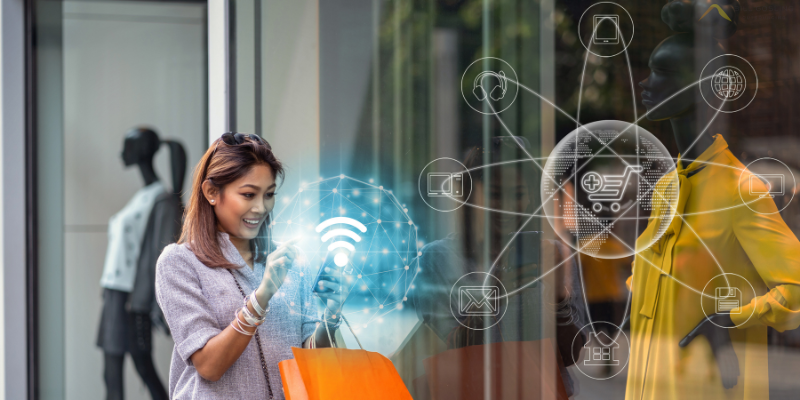Introduction
US-based luxury furniture manufacturer Value City Furniture was experiencing sleepless nights. Heavy investment with no traction left them vulnerable, while the trepidation of getting things moving enticed them to try new things.
The giant furniture manufacturer created a platform named Easy Pass. The platform bridged the data gap between online carts and physical stores. Customers could browse products online, add them to carts, and request salesmen at physical stores to brief them about the product.
Little did people at Value City Furniture know that their sophisticated paradigm—omnichannel customer experience—would become mainstream and be the reason why companies like Disney and Amazon would rule the Internet.
What is Omnichannel Customer Experience?
For a customer, the omnichannel Experience is made up of multiple individual touchpoints that converge at a point to help customers continue browsing from where they left off, irrespective of the platform they are currently on.
For organizations, omnichannel Experience is a cross-channel content strategy businesses use to meet users at varied touchpoints. Omnichannel is one route that allows organizations to assist customers at all steps of their journey.
Omnichannel offers customer service agents a bird’ s-eye view of the customer journey. This view helps agents identify the product or service the customer wants help with. Designed innately, these bird’ s-eye views assist agents in identifying the channels a customer uses for payment, raising queries, and receiving solutions.
To achieve omnichannel expertise, organizations need to identify and overcome functional silos. Small businesses quickly develop omnichannel knowledge because they have smaller units and limited users, which allows them to experiment with structural changes.
An study reveals that 88% of customers get frustrated when they have to repeat their issue to multiple representatives, which explains why organizations need to invest in omnichannel customer experience management. An omnichannel customer service is a multimodal approach to catering to the same customer on varied channels without any gap.
Why is Omnichannel of Paramount Importance Now?
Everyone from CEOs of Fortune 500 companies to marketing gurus is discussing omnichannel. At marketing events, omnichannel is mentioned more than all the attendees.
While omnichannel stands for delivering a seamless experience, it also sanctions additional benefits like:
It Saves Time: When organizations invest in omnichannel capabilities, they give users the freedom to browse products from anywhere at any time.
Also, 77% of customers are likely to buy from a company that helps them save time.
Since 72% of customers want to avoid repeating their problems to multiple agents over various platforms, organizations can integrate Omnichannel capabilities in customer service to allow customers to get their queries resolved faster.
It Empowers Users: 80% of customers are likely to engage with a brand that allows them to shop flexibly. In 2023, 50% of all e-commerce transactions were from mobile devices.
Also, companies that allow customers to shop from multiple channels have 30% higher CLV than the ones that don’t.
How E-commerce Businesses Can Leverage Omnichannel Expertise?
E-commerce, Logistics, and the Fintech industry are growing at 25%, 9.4%, and 19.2%, respectively. E-commerce alone can be credited for the boom it brought in for Fintech and Logistics. Peer-to-peer transactions power fintech’s growth, but it was e-commerce that pushed customers to continue using the mobile-based payment system.
E-commerce marketplaces have coaxed the logistics industry to develop technological capabilities that allow users to track their packages in real-time. E-commerce has leveraged the potential growth in Fintech and the Logistics industry to help customers keep track of all payments and packages in transit.
E-commerce players like Amazon, Alibaba, and Groupon have used omnichannel expertise to acquire and retain customers. Leveraging omnichannel capabilities across the buyer’s journey has helped industry leaders build an unbeatable reputation.
How can E-commerce Players Think about “Omnichannel”?
By delivering a seamless experience across the channels, e-commerce organizations can reduce their churn rate and earn increased CSAT ratings. Below are the three areas where omnichannel can come in handy for e-commerce organizations:
- Technology
- Customer Service
- Marketing
With 86% of customers willing to pay extra for an improved experience, e-commerce players have hit the jackpot.
Marketplaces like Amazon introduced a Prime program that charges customers to offer an enhanced customer experience. For the meagre subscription fee, customers are provided with multiple benefits. Customers think they are winning, but it is the marketplaces that win.
Amazon Prime, for example, offers free music, access to movies from around the world, and unlimited one-day and free deliveries. While the relationship between subscription packages and omnichannel customer experience is not so direct, it is an exceptional example of garnering benefits by invoking a fear of missing out among customers.
Technology
Technological advancements are blurring the line between real-life and online experiences. E-commerce players are leveraging these nuanced advancements to offer an experience that improves customer satisfaction and reflects positively in CLV numbers.
Document Management:
E-commerce players have struggled dramatically with furnishing know-your-customer compliance documents. For example, if Amazon decided to collect KYC documents from all its customers, its agent would have to visit over 100 million Prime customers alone. Imagine collecting, documenting, verifying, and managing these 100 million+ documents Bank of America is a forerunner financial institution that holds roughly 30% of the market and up to 11% of the entire deposit. Through just one mobile-based app, Bank of America allowed its users to check balances, raise transaction requests and get checks processed. It was the first time a bank accepted photos of the check as legit.
Later, E-commerce players started relying on the same technology for KYC verifications. Once documents are uploaded online, they are cross-verified with data available to the government. In the coming times, the same technology can be implemented on varied fronts to facilitate a smoother shopping experience.
Document Management
Source: Bank of America
Geotagged Support
Whether finding a cab or ordering food, geotagging helps aggregators assign the closest driver or delivery agent. GPS has ushered online businesses to create an exceptional customer experience.
E-commerce players can learn from aggregators and leverage geotagging to offer an out-of-the-box customer experience. Many existing players rely on the GPS network to help customers receive products faster.
Online stores inform people about the availability of products at the nearest shops or kiosks and offer them the opportunity to pick them up on their way to work. Users can browse products, pay for them on the app, and pick them up if they need them as soon as possible.
Here’s how geotagging can be used for improving the overall Experience:
- Assigning the closest technician to assemble a newly delivered TV.
- Faster and easier return pickup by agents closest to the pickup address.
Augmented Reality
An Invespcro study revealed that 30% of all products ordered online are returned. 22% of products were returned due to retailer mistakes, whereas 24%were returned because they looked different from the site.
To combat return rates and increase customer satisfaction, Lenskart, an Indian eyewear retail chain, implemented a 3D Try-On feature on its online store. The feature is powered by Augmented Reality technology and helps customers visualize how a particular frame will look on them.
Other e-commerce players can leverage AR technology to clearly understand the product beforehand, leading to minimized return rates and increased customer satisfaction.
Source: Lenskart
Virtual Reality
eBay launched the world’s first virtual reality department store, with over 12,500 products available for viewing in 3D. Here are some of the highlights of the VR store:
- Inventory lists and pricing are updated in real time.
- Customers need to stare at the “add to cart” button to put products in the cart.
- Users get a 3D view of the product, which helps identify the right product.
Customer Service
Offering omnichannel customer service requires organizations to develop integration between text, Email, calls, and social media. This will create a unified brand experience, allowing users to switch channels at their convenience and receive a similar experience.
Here are some strategies organizations can leverage to create an unbeatable omnichannel customer service strategy:
Social Media
46% of customers want their queries answered within 4 hours. For companies with millions of customers, catering to all within 30 minutes through text, chat, or call will require thousands of agents, but with social media, a limited number of agents can cater to millions of customers.
A study that monitored an airline’s Twitter customer service, where all queries were answered within 6 minutes, reveals:
- Speedy response helps control customer churn.
- Impacts customer satisfaction positively
- Increases the customer lifetime value by $20
Text Messages
An independent study found that “99% of all text messages are read.” Text messages are easy to configure and double as a two-way street. Businesses can not only let customers reach them via text messages but also answer queries and keep customers updated through text messages.
BFSI and Fintech organizations have leveraged the hidden power of text messaging like no other industry, and here’s what we learn from them:
- Use text messages to keep customers updated about their orders or queries.
- Integrate auto responders with text messages to help customers request updates on account balances, bill due dates, and product ETAs.
- Use text messages to alert customers about potentially fraudulent transactions.
- Provide instant updates and increase the customer satisfaction rate.
Live Chat
As we mentioned earlier, 89% of customers are likely to buy from businesses that help them save time; another study by Forrester reveals that “63% of visitors will revisit sites that have Live Chat enabled.” Live Chat now not only personalizes the Experience but also helps customers get to the desired product or page faster.
Food and cab aggregator companies have struck gold with Live Chat. Their real-time assistance has helped customers improve their buying decisions, and now 44% of users want to be assisted in real time via Live Chat while buying things online.
The additional benefits of implementing Live Chat are
- It reduces the overall bounce rate, which means customers visit more than one page on your site.
- Offers up-selling opportunities.
- Reduced wait time and instant gratification increase the overall CSAT and CLV.
Like social media, Email is also an excellent tool for responding to customers instantly. With Email, enterprises can use the additional space to promote other products or provide a detailed account of the query.
For the e-commerce industry, Email works wonders and helps with customer retention and retargeting. With 56% of the open rate related to cart abandonment and conversion rate, Email is a win-win tool for e-commerce players.
Omnichannel Marketing
E-commerce players need to leverage social media as part of omnichannel marketing to create an incomparable customer experience. By reaching out to customers through varied mediums like Email, social media, and push notifications with unique content for the same product, businesses can create a fear of missing out.
Retargeting: While Email is the best tool for controlling the cart abandonment rate, it can also be leveraged as a product recommendation tool. Abandoned product emails have a 45% open rate, impacting the overall conversion rate.
Here’s how retargeting helps in creating an exceptional customer experience:
- Retargeting the customers who viewed a product with User-Generated Content on social media works wonders. Companies can showcase a video review submitted by a user to impress potential users.
- Retargeting users with newer versions or better Email and social media offers can control the overall churn rate.
Gauging the products customers interact with and then creating a campaign around them will go a long way. Personalized recommendations increase customers’ attention spans and control churn. Such smart use will usher e-commerce players towards greater success in creating an exceptional customer experience.
e-commerce product recommendation
Source Amazon
Using Discounts to Improve Experience:
Industry players have tried it, and nascent players can experiment with it, too. Offering a discount to encourage customers to use a specific platform or payment mode is a great way to improve customer experience.
Through discounts, e-commerce stores can introduce customers to mobile apps and online payment methods that offer a better experience. Flipkart, a leading Indian marketplace, offers up to a 5% extra discount when customers pay online.
Using Discounts to Improve Experience
Source: Flipkart
Final Thoughts on Omnichannel Customer Experience
A Temkin Group study states, “Investing in customer experience innovations can double revenue in 36 months”. With so much riding on customer experience, ignoring it is like setting yourself up for failure.
Small userbases and top-notch methodologies helped small businesses get a head start in offering quality experiences, but big players have finally caught up. Industry leaders have levelled the battlefield by leveraging state-of-the-art technology and acquiring small players that specialize in optimizing the customer experience.
50% of companies are already redirecting their marketing funds towards customer experience innovations, which makes customer experience the most prominent brand differentiator. E-commerce players have all the state-of-the-art technologies in their suitcases and a young user base that craves innovation. By taking one step at a time, they can succeed at creating an experience that makes them stand out, like Amazon and Disney.
Read our whiteapper on – How Right Party Connect (RPC) Drives Revenue Growth & Engagement




